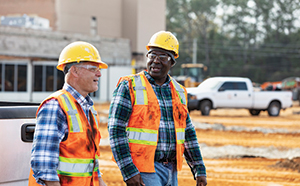Developers affected by rising rates
 |
Developers of apartment buildings across the U.S. are raising alarms as property insurance rates continue to rise, a trend that threatens housing construction—especially new apartments with affordable units, according to Bloomberg.
Premiums and deductibles for policies required by mortgage lenders have risen two- to three-fold during the past five years, developers say. These changes across the industry are fueled by increasingly frequent and severe natural disasters; multifamily housing developers in states such as California, Florida, Louisiana and Texas are seeing triple-digit increases in costs as insurance providers adjust to extreme weather connected to global climate change, according to industry leaders. Crime risk is another factor cited by affordable housing providers in the U.S. for insurance struggles.
High interest rates have led to financing gaps for in-progress projects because developers have limited ability to pass along higher costs to renters, causing deals to idle or fall apart. Insurance carriers also are increasingly raising premiums or declining to underwrite general liability policies for subsidized apartment projects.
“Ultimately, affordable housing providers may be forced to consider whether to opt out from participation in the affordable housing market if insurance and other operating costs continue to outpace allowable rent,” says Michelle Norris, executive vice president of National Church Residences, Columbus, Ohio.
In June, the National Association of Home Builders adopted an emergency resolution urging policymakers at all government levels to take action. The resolution states private insurance providers are “increasingly and dramatically raising insurance rates and deductibles for affordable housing” and “rent-restricted housing … is increasingly not feasible in many areas of the U.S. due to these high insurance costs.” However, lawmakers are divided over the root of the issue.
Owens Corning progresses on shingle recycling initiative
 |
NRCA member Owens Corning, Toledo, Ohio, has made progress on two key shingle recycling workstreams important for reaching its goal of recycling 2 million tons of shingles per year in the U.S. by 2030.
“The progress being made at the pilot is a promising step toward the future of shingle recycling,” says Gunner Smith, Owens Corning Roofing’s president. “What started at lab scale as shingle deconstruction with benchtop materials and testing has now been proven at pilot scale. The next step is plant trials where we will utilize the extracted materials in the development of new prototype shingles.”
Owens Corning also is committed to accelerating the use of recycled shingles in asphalt paving applications; the company has partnered with the National Center for Asphalt Technology to conduct research studies regarding the use of recycled shingles in pavement. Full life cycle assessment data will be generated and published in industry-wide guidelines to educate asphalt contractors in the U.S
Survey highlights construction firms’ workforce challenges
 |
A recent workforce survey of more than 1,400 construction firms, conducted by the Associated General Contractors of America and Autodesk, shows few candidates have the basic skills needed to work in high-paying construction careers, forcing contractors to find new ways to keep pace with demand.
Eighty-five percent of construction firms surveyed report they have open positions, and 88% of those firms are struggling to fill some of those positions, particularly among the craft workforce that performs most on-site construction work.
All types and sizes of construction firms are experiencing these challenges. Ken Simonson, AGC’s chief economist, says the labor shortage is so severe because most job candidates are not qualified to work in the industry. Sixty-eight percent of firms report applicants lack the skills needed to work in construction, and one-third of firms report candidates cannot pass a drug test.
Workforce shortages reportedly also are contributing to the effects of supply chain disruptions, such as delayed materials and higher prices. Sixty-five percent of firms report their projects have been delayed because of supply challenges, and 61% of firms have delayed projects because of labor shortages. Half the survey respondents report owners canceled, postponed or scaled back projects because of increasing costs.
To combat labor shortages, 81% of firms have raised base pay rates for their workers during the past year, 44% are providing incentives and bonuses, and 26% also have improved their benefits packages. Additionally, 63% of survey respondents—compared with 39% in the 2022 survey—report they are using online strategies such as social media or digital advertising to recruit workers.
Contractors have increased training to address candidates’ lack of skills with 41% of firms boosting spending for training and professional development programs, 25% enhancing their online and video training capabilities, and 14% using augmented and virtual reality technology to better train workers.
Survey results show technology has become more crucial in combatting the labor shortage. Seventy-five percent of respondents say using cutting-edge technology helps them recruit talent, and 91% say their employees must have digital technology skills.
Additionally, 44% of respondents say artificial intelligence and robotics will positively affect construction costs by automating manual, error-prone tasks. Forty-one percent say AI and robotics will improve the quality of construction jobs and make workers safer and more productive.
CPWR develops resources for aging construction workers
 |
The Center for Protection of Workers’ Rights has developed a series of resources for older workers in the construction industry through its Center for Construction Research and Training, according to Safety+Health magazine. The Bureau of Labor Statistics reports the average construction worker is 42 years old, and many workers expect to remain on the job longer because they are “influenced by financial pressures as well as job satisfaction.”
CPWR’s resources include a data dashboard, hazard assessment and primary prevention tools, supportive programs and legal resources. CPWR also offers guidance regarding fall prevention and protection; health and wellness promotion; heat-related illness prevention; lighting; manual materials handling; noise and hearing loss; safety climate; and site management and housekeeping. Examples of supportive programs include pairing younger workers or apprentices with older tradespeople, bidirectional mentorship and training for career ladders.
Resources can be accessed on cpwr.com/research/management-resources-from-research/aging-workers.
COMMENTS
Be the first to comment. Please log in to leave a comment.